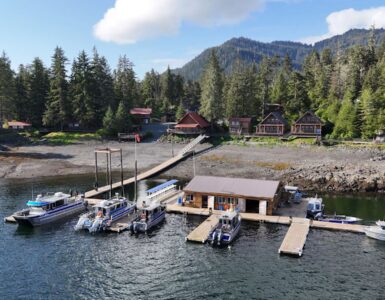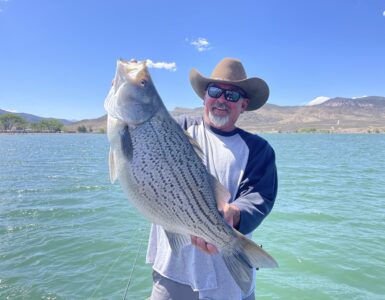(tonya intro) Welcome to KSL Outdoors, I’m tonya Kieffer. We are down here in Price, Utah on a really snowy morning in March. Down in the SE Region DWR and we are getting ready to go on a bear denning.
It’s cold, snowy and muddy as we embark on our quest to find a bear that biologists know very well.
(Brad Crompton, UTAH D.W.R. Wildlife Biologist) It was captured as an orphaned cub 5 years ago. Its mother lived on a mountain west of Price, and had killed some sheep, and had to be dispatched by a government trapper. When we have orphaned cubs, we go retrieve them and they are taken care of at a facility. We basically fed it for a while, and took it to boise where they fed it all summer, and they gave it back to us in the fall and we let it go right at this spot in December. It survived out here for five years, since then. Its kind of a neat story.
Each spring biologists venture into bear dens across the state, in a continuing effort to learn more about Utah’s bear population.
(Brad Crompton) Across, the state of Utah, there are a number of female bears that we have radio collared and each winter we go into their bear dens to see if they have had cubs and then the following year, if the cub survived. Bears are something that’s difficult to count, so its difficult to estimate how many bears there are across the state and this is an indicator of whether bear populations are increasing or decreasing.
(Brad) We’re mandated to manage healthy populations of wildlife across the state, and bear populations are included. But also a huntable portion of that as well, and hunter opportunity.
We were accompanied by wildlife biology students and professors from USU. Who are here looking for some hands on field experience.
(Rich Echberger, USU Wildlife Professor) Being a wildlife biologist and being a wildlife student is really a legacy. 30:31 We count on folks from UDWR to pass that legacy on and their experience. As professionals, they have all the experience out here in the field, to pass that on to the next generation of wildlife biologists, so its extremely important.
(Levi Simmons, USU Student) If this world has any chance of sustain-ability, then it’s going to need proper stewardship, and proper training, and without the opportunities presented by the DNR, then we would never get these extracurricular activities and further education.
Southeastern Utah has some of the highest bear densities in the state. To find the bears that have been collared, biologists use this radio telemetry antennae, which receives a signal that should lead us directly to the bears den.
(Brad) This will get louder as we get closer. Right now you can just barely hear it one direction so you know that’s where it is. As we get closer it will be kind of faint here, and really loud there, and you just keep going to where you can get closer and then you circle around it and go on in.
Bears typically den in remote, hard to get to locations. This bear has us starting in the bottom of the Book Cliffs and her signal led us, nearly to the top, where we find her den, under this large boulder.
(Brad) Sounds like she has cubs cuz there’s some squeeling of cubs in there. Haven’t peeked my head in there yet but. (tonya) is that the look of excitement? (brad) yeah, we don’t want to walk for nothing right?
(Brad) We’ll go around this rock and kind of set up camp there. Load up the drugs, dart her, and we’ll have to wait ten minutes while it’s quite and then we’ll pull those cubs out.
(Brad) She’s awake right now, she’s looking right at us. (tonya) she looked right at me! (brad) yeah she’s wide awake.
The mama bear knows that we are here. Brad has to work fast and mix up a cocktail of drugs into this syringe that will be fired from this air gun before she decides to come out to investigate the intruders.
(brad) come on bear give me a shot.
Brad has to make the shot count. He doesn’t want to miss or injure the sow or her cubs.
(Cubs cry) (brad) I know, you are hungry and cold
That means he’ll have to go further in the den to get a shot.
(pause)….(shot) (brad) ok backpack.
(Tonya tag, toss to quiz)Well guys, we made it to the top of the Book Cliffs. I wasn’t sure we were all gonna make it. I was a little nervous myself. I give a lot of credit to those hunters out that there that are hunting this area. But we are right outside, of the bear den itself. We’ve tranq’d her. We’re going to wait a few more minutes and we’re going to work up her and the babies we can hear inside. But you know what, let’s go ahead and take a look at tonight’s quiz question.
(Tonya Intro) Welcome back to KSL Outdoors, I’m Tonya Kieffer. Well we’ve got the bear tranquilized, we are getting ready to pull her out and we are going to touch the baby bear cubs, let’s go see what is in the den.
(Baby bear comes out) oh my gosh Tiff, put it in your coat, put it in your coat.
(Brad) They are about 5-6 weeks old, early February, late January, is usually when their born.
(Brad) The cubs will be with their mother for an entire year, and they’ll go into the den with them next year as yearlings, and then the following spring, a year from now, they will leave their mother, and disperse and be by themselves.
(Brad) The yearlings next year, they’ll be asleep like their mother. Right now, as cubs, their awake because they need some food.
(Brad) Bears have a very diverse diet. They can eat all kinds of things, but early in the spring, when they first come out, it’s mainly grasses and forbes, and whatever is green and available. Later in the summer, they will switch to bugs and other insects, and berries, and nuts. They’ll eat a whole bunch in the late summer and fall, before they hibernate just to build on fat reserves. So they are ready for the winter, and start it all over next spring.
(USU Student) I’m extremely excited right now. Pretty amazing experience. Definitely re-substantiates that I am on the right path of pursuing this degree.
(Cambree Carroll, USU Student) This is definitely a great experience, and as fun as it is, I think the importance behind it is that the work thats being done here. And you need to realize what’s going on because we do have an impact on the world around us, and I think the idea behind the students at USU is that we are giving back to the world and we are taking care of it, and making sure that life like this is still possible.
The cubs are kept from their mother as little as possible. With the sow sound asleep, Brad dives into the den to take care of momma bear.
(Brad) All is well. Everything looks perfect in there. We gave her a brand new radio collar so we can track her for five more years. She has two healthy cubs. She looks good, breathing good. Everything worked out well.
(brad at other den) it’s just right there. (biologist) is there cubs? (brad) no.
Brad will visit other dens of bears that have been captured and collared this year. Each time they do, they get a little more information, one more piece of the puzzle on how bears in Utah are doing.
(Brad) that’s why we are doing this study it’s an opportunity to look at production in bears, cub production as an indicator on how the population is doing. We’ve had radio collars on for almost ten years and these bears have done very well even in the dry years and they do especially well when you have a wet cycle. So I think the, especially in the Book Cliffs and in Carbon County they are stable to increasing.
(Rich Echberger, USU Wildlife Professor) This is the kind of thing, that when people ask me how much money do you spend on taking care of those bears, or taking care of those black footed ferrets, or taking care of those geese. You know my thing is its a responsibility for us, we live in this world, and for us to live in a world where we’ve got a healthy environment for human beings. We need to have a healthy environment for the animals and the plants that live there too.
(Brad) Every time when you hike up, everyone is always saying this is the most miserable thing I’ve ever done, I don’t want to do it ever again. On the way out, you want to do it again tomorrow, cause it’s a pretty neat experience.
(Brad) you’ll remember the day you held a bear for the rest of your life.
(Cambree) this is the best school experience I could have hoped for.







Add comment